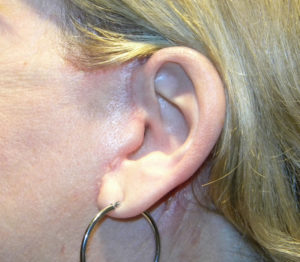The facelift is one of the most common of all facial rejuvenation procedures. While there area a myriad of methods to perform it with various technical maneuvers that can seem bewildering to the patient, the most basic part of it remains the incision around the ears. While perhaps not the most technically challenging part of the operation it is certainly the most visible.
No matter how well the ‘inside’ of the facelift procedure is performed, poor incision placement, adverse scarring and hairline displacements/distortions will be an aesthetic detraction. These external markers can often be how a facelift is judged and is an understandable preoperative patient concern.
The basic facelift incision around the ear is often called preauricular or retrotragal. This refers to the incision on the front of the ear which represents a part of the total facelift and just a minor portion of its total incisional length in most cases. But it is the most visible part of the incision and thus its aesthetic importance.

These type of facelift incision usually heals quite well and as discretely as one would hope. This is because it is not only hidden but because it is closed with no tension after the excess skin is removed.
Dr. Barry Eppley
Indianapolis, Indiana


